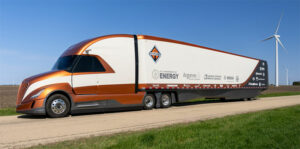Navistar touts 16 mpg from its International SuperTruck II
Navistar is bragging about the mileage its International SuperTruck II is getting –16 mpg.
The truck maker is developing the Class 8 tractor in partnership with the U.S. Department of Energy.
This is the second SuperTruck. The International SuperTruck I was built in 2009.
This truck demonstrates 16 miles per gallon fuel efficiency through hybridization and a 170% improvement in freight efficiency, among other advancements over the 2009 baseline vehicle, SuperTruck I, the company recently announced.
The prototype truck is lighter, has improved rolling resistance, is more aerodynamic, and has a powertrain “designed to deliver premium freight efficiency to assist in reducing U.S. dependency on fossil fuels in the commercial vehicle sector,” according to the company.

International SuperTruck II was built as a hybrid vehicle featuring a combustion engine with high-voltage accessories and technologies, developed in partnership with Bosch. Engine improvements were made in key areas, including combustion, friction, gas exchange, and airflow through the engine.
A redesigned cylinder head with a dual overhead cam engine and enhanced fuel system resulted in a 2% fuel economy improvement when compared to International SuperTruck I.
Aftertreatment system improvements included diesel exhaust fluid dosing, improved mixing and lower restrictions, new selective catalytic reduction formulations for high-nitrogen oxide reduction and reduced cold-start activation time.
‘Next-level efficiency’
“A full-system approach was required to achieve 55.2% brake thermal efficiency,” Jim Cigler, chief engineer for advanced engine at Navistar, said in a company statement.
Brake thermal efficiency is a measure of the fuel efficiency of internal combustion engines. The higher the brake thermal efficiency, the lower the fuel consumption, and greenhouse gas emissions.
“Opportunities were identified by internal engineering teams along with research partner Argonne National Laboratory through detailed analysis and simulation. System suppliers such as Bosch, Jacobs Vehicle Systems, and Applied Nano Systems brought new approaches to key systems that enabled laboratory success and yielded real-world fuel economy improvements. Navistar was able to identify new ways to push our engines to the next level of efficiency,” Cigler said.
Federal funding helped Navistar engineers experiment with technologies not currently available in the Class 8 market, Russ Zukouski, chief engineer for global innovation and principal investigator for the SuperTruck programs, said in the news release.
“The team concentrated its design on high-voltage electrification, utilizing hybrid technology on a path toward full electrification that has the potential to be commercialized in fully electric vehicles and improve customers’ total cost of ownership and business operations,” Zukouski said.
International SuperTruck II has next-generation predictive cruise control. Design engineers also are leveraging technologies and information within the larger Traton Group, a Volkswagen subsidiary, to explore vehicle-to-everything technologies to enhance safety and vehicle efficiencies.
“Our goal is to continue to advance internal combustion engine technology as efficiently and sustainably as possible until there is parity with zero-emissions vehicles,” Dean Oppermann, chief engineer for advanced truck, said in the news release. “Development of both technologies concurrently ensures a smooth transition of technology to best serve customer needs. We are focused on the entire product ecosystem – product development itself, as well as infrastructure charging, service and support of vehicle operation, end of life for batteries.”
Click here to see a video of the International SuperTruck II in action.
Daimler has a SuperTruck too
In February, Daimler Truck unveiled its Freightliner SuperTruck II.
“Enhanced tractor aerodynamics, low-rolling resistance tires, powertrain improvements and energy management with advanced technologies were identified as areas for technology innovations that could potentially enter production for customers in the future,” Daimler said in a news release.
Daimler’s SuperTruck II powertrain has a split cooling system. High-temperature and low-temperature cooling circuits work in tandem with two-stage turbocharging and exhaust gas recirculation cooling on the engine Daimler explained.
“Together, these technologies result in further efficiency gains enabling more aggressive downspeeding,” Dainmler said in a news release.
Adaptive tandem axles allows more torque from the powertrains and automatically shifts from 6×4 to 6×2 at highway speeds, which helps the driver when maneuvering at low speed, the company said.
The U.S. Department of Energy’s SuperTruck program is intended to encourage truck manufacturers to develop a zero-emission heavy-duty truck capable of regional and long-haul freight deliveries. Since the SuperTruck program began in 2009, Paccar, Volvo, Ford Motor Co. and General Motors also have won funds to develop zero-emission trucks. LL









